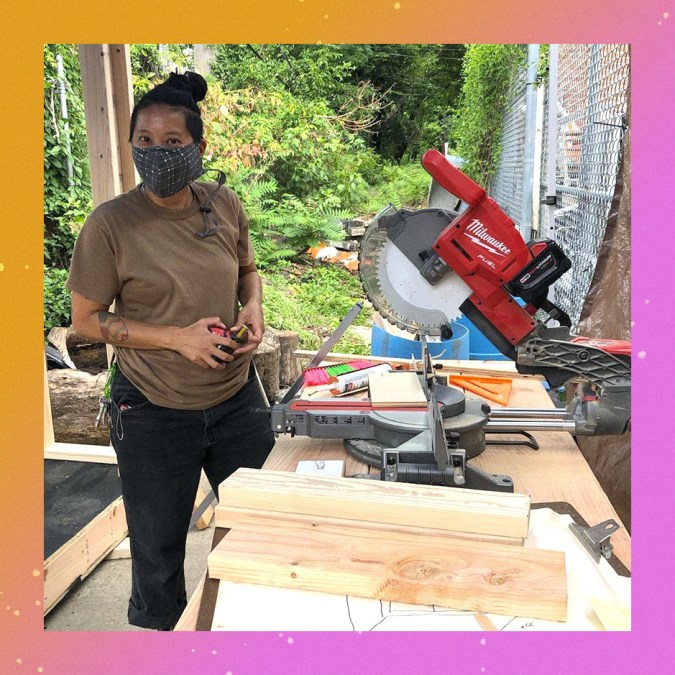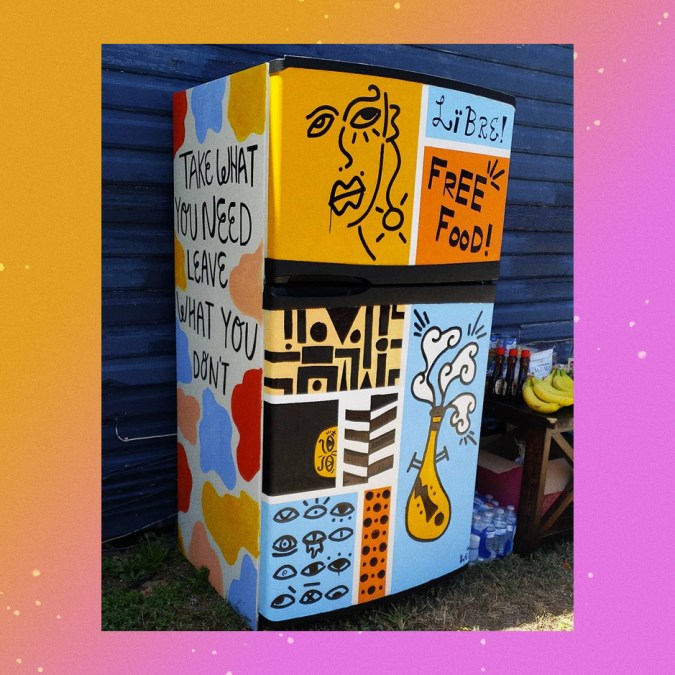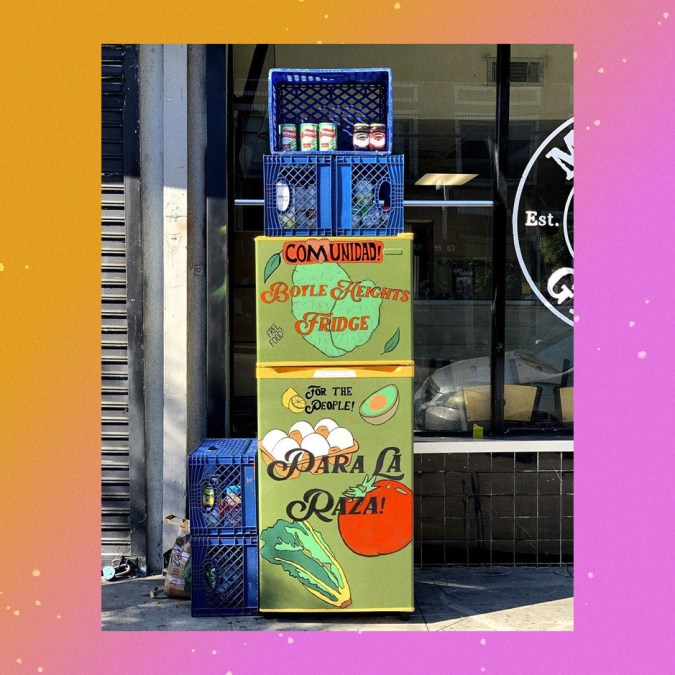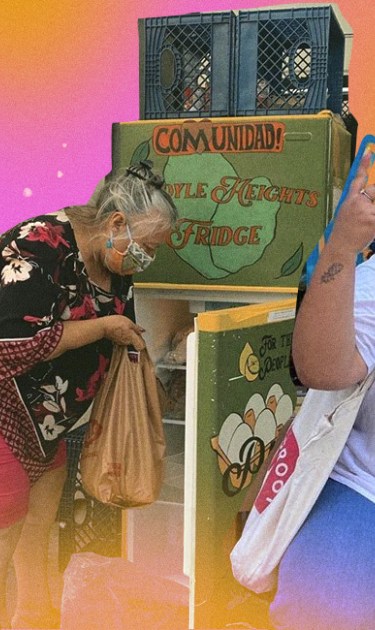On the corner of 80th St. and Northern Blvd. in the Jackson Heights neighborhood of Queens, New York, sits an eye-catching refrigerator. Painted blue with larger-than-life drawings of fruits and vegetables, the vibrant display invites folks to take and drop “free food.” Inside, its shelves are stocked with fresh carrots, tomatoes, lettuce, cilantro, cassava, potatoes and ginger—all donated by local restaurants, supermarkets and everyday people hoping to feed their neighbors.
In the past month, community fridges like the one in Jackson Heights have popped up across the country. The appliances, often donated or purchased for cheap on Facebook Marketplace or Craigslist, source power from a small business and are regularly stocked, sanitized and organized by volunteers who encourage locals in largely low-income communities of color to unabashedly take what they need. Through the process, organizers, who describe the fridges as mutual aid rather than charity, hope to help struggling neighbors.
“Covid really hit us hard. We lost so many community members, and there were also so many people who lost their jobs, who lost money, who can’t put food on the table,” Paulacamila Caceres, one of the core organizers behind the Jackson Heights community fridge, tells Remezcla. “Our goal is to keep our neighbors fed and healthy and to have a larger conversation around food insecurity.”

In 2018, more than 37 million (11.5% of) people in the United States were reportedly food-insecure, meaning they lacked reliable access to enough affordable, nutritious food. Now, the massive loss of jobs, business closures and social distancing orders due to the pandemic have further disrupted the lives of hungry families and put numerous more in need. According to a report from the hunger-relief nonprofit Feeding America, food insecurity is rising in every part of the country. They project that at some point in 2020 about 54 million people—including one in four children—may not know where their next meal is coming from.

The current trend in the U.S. to help combat growing rates of hunger in hard-hit hyper-local communities started back in February in Brooklyn, New York, with the collective A New World in Our Hearts. The group, which has since instituted several fridges across the city, created a guide for how other organizations and individuals can set up their own community fridges. The practice quickly spread, with new installations happening weekly all over the country.

In West Philadelphia, Sonia and Sonam Parikh are in the process of launching their first community fridge. The sisters had already been delivering meals and medical supplies to protesters and were inspired to start The People’s Fridge on 52nd after seeing the trend on social media. For them, the work is as much about helping their neighbors as it is about honoring their late father, a former food justice advocate who died of coronavirus in March.
“For my sister and I, the fridge is a way to memorialize his lifelong commitment to feeding people,” Sonia tells Remezcla. “My dad modeled mutual aid for us consistently growing up through organizing diapers and formula drop-offs, meal shares and sponsoring and arranging regular community meals back home [in India].”

While Sonia says the fridge, which is housed outside of her sister’s coffee shop, has helped her family grieve the death of her father, its objective is to support the people in the community.
“Our goal is to feed people and provide them with the resources they need to create any type of meal. Food should never be a privilege, but it is. This is a part of a larger effort to combat that,” she says.

Elders are among the hardest-hit groups impacted by COVID-19, suffering a disproportionate number of deaths and losing much-needed access to relatives and community members who might have assisted them with groceries and cooking. Oftentimes surviving solely on social security and disability income, many individuals above the age of 65 do not have much extra funds after paying rent, car notes and/or other utilities. In San Antonio, Leslie Rivera is behind a community fridge largely, though not exclusively, serving an elderly neighborhood.

“We want to provide them with food items to alleviate some of the financial burden they are experiencing,” Rivera says. “So many people told us they were homeless in the past or near being homeless and that this [fridge] was something they really needed.”
For Rivera, this work was partly inspired by her grandfather, a former Black Panther who once assisted his community through the party’s free meals program. But her San Antonio fridge, which she operates with nine other core members and some volunteers, is equally about feeding locals as it is about reducing waste. The Food and Drug Administration reports that the U.S. throws away 30 to 40% of its food supply each year. Of the 125 to 160 billion pounds of food that goes to waste annually, much of it is edible, nutritious and could instead be feeding food-insecure families.
Most organizers behind community fridges, including Rivera, partner with local restaurants, supermarkets, urban farmers and/or food pantries, which donate goods they have at excess.
“It busts the myth that there is not enough food. We can address food insecurity and expose food waste—and assist in preventing food waste—through these partnerships [and] by composing the imperfect produce that’s left in the fridge, which we do,” Rivera declares.

While the emerging fridges are helping communities get by, some have argued that these small-scale initiatives don’t solve the massive hunger crisis. For critics, the growing popularity and praise of public refrigerators, while well-meaning, reduce the scale of the problem. Instead, they propose that greater attention should be given to more effective solutions, like implementing better anti-food-waste policies and expanding distribution networks.
Day Hernandez, an organizer behind a community fridge in the Boyle Heights neighborhood of Los Angeles, agrees that the rising trend won’t solve the country’s record-level food and hunger emergencies, but she believes they are forcing the U.S., including elected officials, to confront a dire issue that many don’t even realize occur in the country.
“It’s not going to solve any big issues. We know that. But it can feed some [and] it can be a wake-up call to people in power. It’s small, but it’s the beginning of something bigger,” she says.
At a time when the country is so divided, many of the organizers and volunteers say the community fridges play another critical role: uniting people. While food sharing is a common practice among South Asian countries, routine in Latinx churches, and have been a part of several Black liberation movements, that’s not so much the case elsewhere. In U.S. neighborhoods that encompass people of various backgrounds, organizers say community efforts like this one are bringing people together to dialogue and help one another despite political and cultural differences.
“I’m taken aback by how a community can come together and make something so wonderful happen so seamlessly. Through this, there are new friendships [and] there are new connections in the community. And that’s really a big part of this: to feel connected, come together and be responsible for something bigger than you,” Sonia from Philly says.
You can visit each community fridge’s IG page for more information on how to get involved and/or donate.




